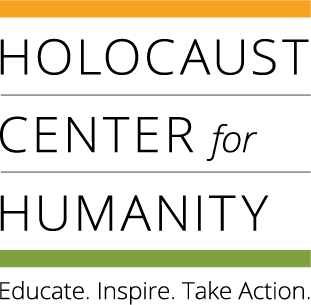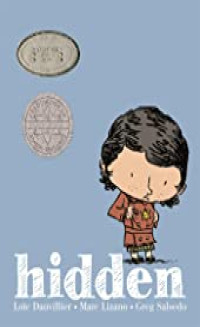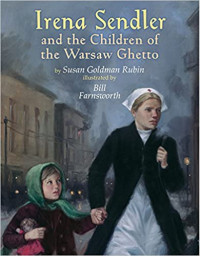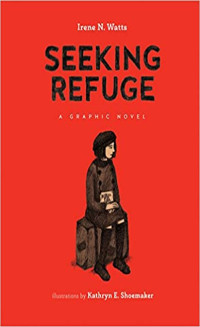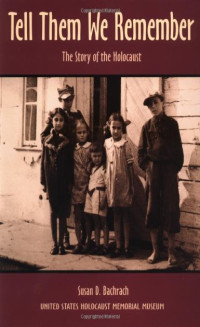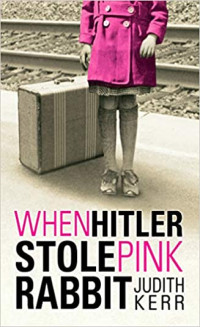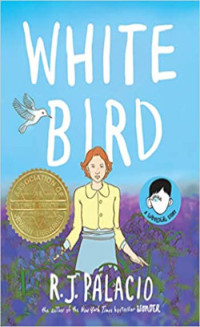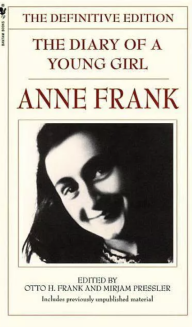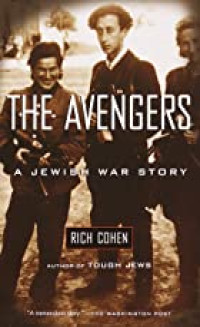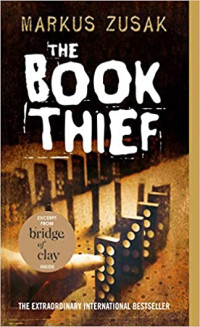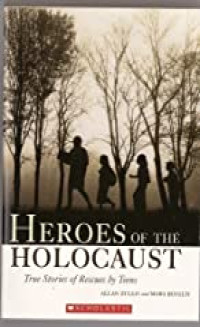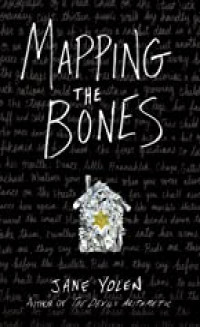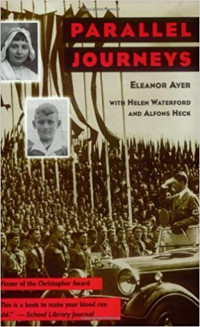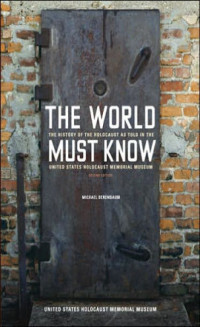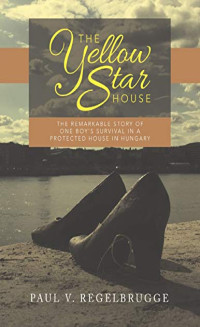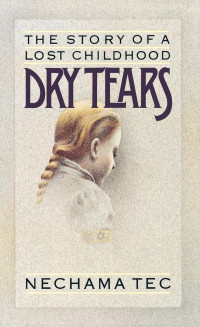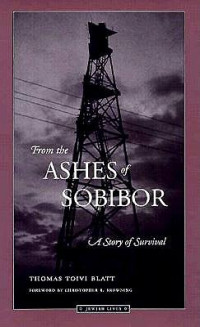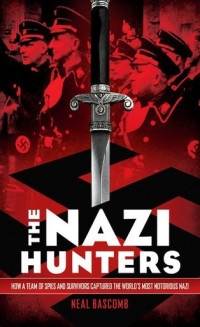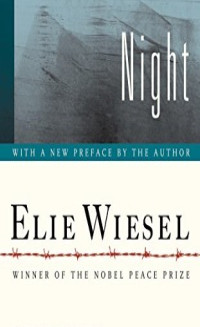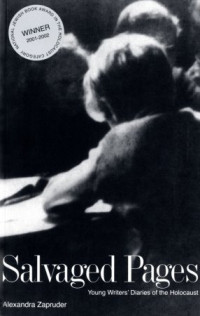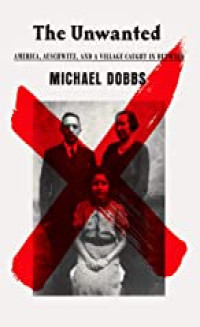
More Recommended Books
Grades 5-6 | Grades 7-8 | Grades 9-12
Grades 5-6
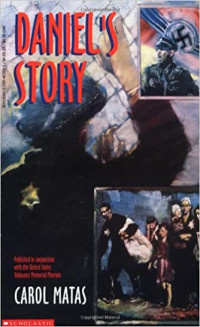
Daniel’s Story, By Carol Matas
Daniel and his family face the dangers threatening Jews in Hitler's Germany in the late 1930's. They are forced from their home in Frankfurt and sent on a long and dangerous journey, first to the Lodz ghetto in Poland, and then to Auschwitz -, the Nazi death camp. Though many around him lose hope in the face of such terror, Daniel, supported by his courageous family, struggles for survival. He finds hope, life and even love in the midst of despair. Daniel's Story Teacher Guide | Borrow a classroom set of this title
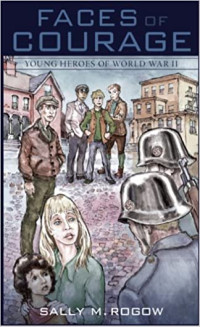
Faces of Courage: Young Heroes of WWII, By Sally Rogow
Faces of Courage is an inspiring compilation of twelve stories of courageous teenagers from all across Europe who resisted the Nazis. Faces of Courage Teacher Guide
Friedrich, By Hans Peter Richter
His best friend thought Friedrich was lucky. His family had a good home and enough money, and in Germany in the early 1930s, many were unemployed. But when Hitler came to power, things began to change. Friedrich was expelled from school, and then his mother died and his father was deported. For Friedrich was Jewish. Friedrich Teacher Guide
 Hana’s Suitcase: A True Story, By Karen Levine
Hana’s Suitcase: A True Story, By Karen Levine
A biography of a Czech girl who died in the Holocaust, told in alternating chapters with an account of how the curator of a Japanese Holocaust center learned about her life after Hana's suitcase was sent to her. Hana's Suitcase Teacher Guide
Hidden: A Child’s Story of the Holocaust (graphic novel), By Loic Dauvillier, Marc Lizano, Greg Salsedo
In this gentle, poetic young graphic novel, Dounia, a grandmother, tells her granddaughter the story even her son has never heard: how, as a young Jewish girl in Paris, she was hidden away from the Nazis by a series of neighbors and friends who risked their lives to keep her alive when her parents had been taken to concentration camps. Hidden Teacher Guide
Irena Sendler and the Children of the Warsaw Ghetto, By Susan Goldman Rubin, Illustrated by Bill Farnsworth
This book tell the story of Irena Sendler—the “female Oskar Schindler”—who took staggering risks to save 2,500 children from death and deportation in Nazi-occupied Poland during World War II—now adapted for a younger audience. Irena Sendler was a young Polish woman living in Warsaw during World War II with an incredible story of survival and selflessness. And she’s been long forgotten by history. Irena Sendler and the Children of the Warsaw Ghetto Teacher Guide
Number the Stars, by Lois Lowry
As the German troops begin their campaign to "relocate" all the Jews of Denmark, Annemarie Johansen’s family takes in Annemarie’s best friend, Ellen Rosen, and conceals her as part of the family. Through the eyes of ten-year-old Annemarie, we watch as the Danish Resistance smuggles almost the entire Jewish population of Denmark, nearly seven thousand people, across the sea to Sweden. Number the Stars Teacher Guide | Borrow a classroom set of this title
Seeking Refuge (graphic novel), By Watts & Shoemaker
In this follow-up to the successful Goodbye Marianne, Irene Watts explores what it is like for a young refugee girl to flee Nazi-occupied Austria alone. The poignant story is relatable to the terrible situation facing refugees in Europe and around the world today.
Sharing is Healing, By Noemi Ban
Several themes pervade each chapter: the importance of perseverance, determination, friendship, responsibility and freedom; the dangers of bigotry, hatred and teasing; and as the title implies, the value of family, friends, trust and sharing in healing from a great loss. The final two chapters include narrative and photos from Mrs. Ban’s return to Auschwitz in 1995 and 1997, as well as suggestions to readers as to lessons that may be learned from this period of history.
Tell Them We Remember, By Susan Bachrach
Drawing on the United States Holocaust Memorial Museum's large collection of artifacts, photographs, maps, and taped oral and video histories, this book tells the story of the Holocaust and how it affected the daily lives of Jewish, Roma (Gypsy), disabled, and Polish Catholic children. Those who survived to become adults passed on the stories of relatives and friends who had been killed, with the hope that the terrible crimes of the Holocaust would never be forgotten or repeated.
When Hitler Stole Pink Rabbit, By Judith Kerr
Based on the gripping real-life story of the author, this poignant, suspenseful middle-grade novel has been a favorite for over forty years. Anna is not sure who Hitler is, but she sees his face on posters all over Berlin. Why do their parents keep insisting that Germany is no longer safe for Jews like them? Because of Hitler, Anna must leave everything behind. When Hitler Stole Pink Rabbit Teacher Guide
White Bird, By R.J. Palacio
White Bird follows a young Jewish girl, hidden by a family in a Nazi-occupied French village during World War II and the boy she and her classmates once shunned that becomes her savior and best friend. Sara's harrowing experience movingly demonstrates the power of kindness to change hearts, build bridges, and even save lives. As Grandmère tells Julian, "It always takes courage to be kind, but in those days, such kindness could cost you everything. White Bird Teacher Guide
Grades 7 & Up
Anne Frank: Diary of a Young Girl
In 1942, with the Nazis occupying Holland, a thirteen-year-old Jewish girl and her family fled their home in Amsterdam and went into hiding. In her diary Anne Frank recorded vivid impressions of her experiences during this period. By turns thoughtful, moving, and surprisingly humorous, her account offers a fascinating commentary on human courage and frailty and a compelling self-portrait of a sensitive and spirited young woman whose promise was tragically cut short. Anne Frank Teacher Guide | Borrow a classroom set of this title
The Avengers, By Rich Cohen
Abba Kovner, Vitka Kempner, Ruzka Korczak-comrades, lovers, friends. In the Lithuanian ghetto of Vilna, they were the heart of a breathtakingly courageous underground movement, and when the ghetto was liquidated, they fled to the forests and joined other partisans in continued sabotage and resistance. Riveting, poignant and uplifting, The Avengers is a powerful exploration of resistance and revenge, of courage and dedication, and an inside look at some of the intrepid individuals who fought against the Holocaust and the nazi occupation of Europe. The Avengers Contextual Information
The Book Thief, By Markus Zusak
It is 1939. Nazi Germany. The country is holding its breath. Death has never been busier, and will become busier still. Liesel Meminger is a foster girl living outside of Munich, who scratches out a meager existence for herself by stealing when she encounters something she can’t resist–books. With the help of her accordion-playing foster father, she learns to read and shares her stolen books with her neighbors during bombing raids as well as with the Jewish man hidden in her basement. The Book Thief Teacher Guide
The Devil’s Arithmetic, By Jane Yolen
Hannah is tired of holiday gatherings−all her family ever talks about is the past. In fact, it seems to her that's what they do every Jewish holiday. But this year's Passover Seder will be different−Hannah will be mysteriously transported into the past . . . and only she knows the unspeakable horrors that await. Devil's Arithmetic Teacher Guide
Heroes of the Holocaust: True Stories of Rescues by Teens, By Allan Zullo & Mara Bovsun
This slender little paperback, with its ample leading, simple sentence structure and largish print, is enough to restore one’s faith in mankind and perfect to introduce the Holocaust to readers as young as 10 years old and as old as 14, although the stories all involve teens. The authors point out that these brave people were not adult resistance fighters, but just youngsters who willingly placed their own lives in jeopardy for the sake of saving Jews because they knew it was the right thing to do. Heroes of the Holocaust Teacher Guide
Mapping the Bones, By Jane Yolen
From the best-selling and award-winning author of The Devil's Arithmetic, Jane Yolen, comes her first Holocaust novel in nearly thirty years. Influenced by Dr. Mengele's sadistic experimentations, this story follows twins as they travel from the Lodz ghetto, to the partisans in the forest, to a horrific concentration camp where they lose everything but each other.
Milkweed, By Jerry Spinelli
Milkweed explores the story of a young Holocaust orphan who lives in the streets of Warsaw. He steals food for himself, and the other orphans. He wants to be a Nazi, with tall, shiny jackboots of his own-until the day that suddenly makes him change his mind. And when the trains come to empty the Jews from the ghetto of the damned, he's a boy who realizes it's safest of all to be nobody. Milkweed Teacher Guide
 More Than Any Child Should Know: A Kindertransport Story of the Holocaust, By Paul Regelbrugge and Julia Thompson
More Than Any Child Should Know: A Kindertransport Story of the Holocaust, By Paul Regelbrugge and Julia Thompson
More Than Any Child Should Know is a graphic novel that tells the story of beloved Seattle Holocaust survivor, Steve Adler, who passed away in 2019. Following the events of Kristallnacht (The Night of Broken Glass) in November 1938, Steve and his family were desperate to escape increasing Nazi persecution of Jews in Germany. The nine-year-old Steve was among 10,000 children sent to England through the Kindertransport (children's transport) in 1939, where he lived as a refugee in group and foster homes. Read More and Discussion Questions | Borrow a classroom set of this title
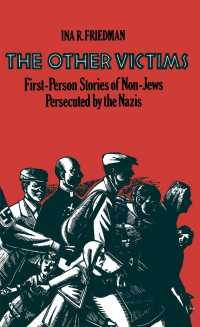 Other Victims: First Person Stories of Non-Jews Persecuted by the Nazis, By Ina Friedman
Other Victims: First Person Stories of Non-Jews Persecuted by the Nazis, By Ina Friedman
A series of personal stories from some of the non-Jews, including gypsies, political and religious activists, the physically challenged, and other "undesirables," who were persecuted but escaped the fate of the five million Gentiles murdered by the Nazis.
Parallel Journeys, By Eleanor H. Ayer
She was a young German Jew. He was an ardent member of the Hitler Youth. This is the story of their parallel journey through World War II. Parallel Journeys Teacher Guide
Refugee, By Alan Gratz
Josef is a Jewish boy living in 1930s Nazi Germany. Isabel is a Cuban girl in 1994. Mahmoud is a Syrian boy in 2015. All three kids go on harrowing journeys in search of refuge, facing unimaginable dangers -- from drownings to bombings to betrayals. But there is always the hope of tomorrow. And although Josef, Isabel, and Mahmoud are separated by continents and decades, shocking connections will tie their stories together in the end.(Amazon) Refugee Teacher Guide
The World Must Know, By Michael Berenbaum
The World Must Know documents the compelling human stories of the Holocaust as told in the renowned permanent exhibition of the United States Holocaust Memorial Museum in Washington, D.C. Drawing on the museum's extensive collection of artifacts, archives, and eyewitness testimonies, and augmented with more than two hundred period photographs, this book serves as an enduring reminder of the moral obligations of societies and individuals.
We Are Witnesses: Five Diaries of Teenagers Who Died In The Holocaust, By Jacob Boas
The five diarists in this book did not survive the war. But their words did. Each diary reveals one voice, one teenager coping with the impossible. These stark accounts of how five young people faced the worst of human evil are a testament, and an inspiration, to the best of the human soul. We Are Witnesses Teacher Guide
Yellow Star House, By Paul Regelbrugge (grade 8 and up)
Between May 15 and July 9, 1944, over 440,000 Hungarian Jews were deported and, most were murdered at Auschwitz-Birkenau. The sole exception was the Jews in Budapest. In October 1944, Nazi Lieutenant Colonel Adolf Eichmann, with the eager assistance of the Hungarian fascist Arrow Cross party, initiated plans to finish off the Jews of Budapest even as the Soviet Red Army was rapidly advancing, and ultimately laid siege on Budapest in December 1944. This is the story of how one Jewish boy and 400 others were protected in a "yellow star house." | Borrow a classroom set of this title
Grades 9-12 & Up
Teacher guides and/or discussion questions available for all of these titles. Just let us know what you need.
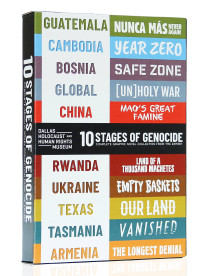
Ten Stages of Genocide Graphic Novels Set
Explore Dr. Gregory Stanton’s Ten Stages of Genocide through graphic novels made exclusively for the Dallas Holocaust and Human Rights Museum. Each graphic novel vividly depicts a different genocide through harrowing stories of survival.
Available from the Dallas Holocaust and Human Rights Museum.
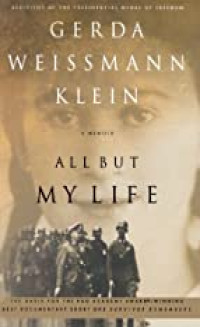
All But My Life, By Gerda Weissmann Klein
All But My Life is the unforget table story of Gerda Weissmann Klein's six-year ordeal as a victim of Nazi cruelty. From her comfortable home in Bielitz (present-day Bielsko) in Poland to her miraculous survival and her liberation by American troops--including the man who was to become her husband--in Volary, Czechoslovakia, in 1945, Gerda takes the reader on a terrifying journey. All But My Life Teacher Guide | Borrow a classroom set of this title
Dry Tears, By Nechama Tec
This is the true story of Nechama Tec, whose family found refuge with Polish Christians during the Holocaust. Dry Tears is a dramatic tale of how an eleven-year-old child learned to "pass" in the forbidding Christian world and a quietly moving coming-of-age story. This book is unique celebration of the best human qualities that surface under the worst conditions. Dry Tears Teacher Guide
From the Ashes of Sobibor, By Thomas Toivi Blatt
From the Ashes of Sobibor: A Story of Survival is an invaluable, firsthand account of a twelve year old child's survival in a Nazi concentration camp in Poland during World War II. He and his family lived in the largely Jewish town of Izbica in the Lublin district of Poland—the district that was to become the site of three major Nazi extermination camps: Belzec, Sobibor, and Majdanek. Blatt tells of the chilling events that led to his deportation to Sobibor, and of the six months he spent there before taking part in the now-famous uprising and mass breakout.
In My Hands, By Irene Gut Opdyke
When the war began, Irene Gut was just seventeen: a student nurse, a Polish patriot, a good Catholic girl. Forced to work in a German officiers' dining hall, she learns how to fight back. Irene eavesdropped on the German's plans. She smuggled people out of the work camp. And she hid twelve Jews in the basement of a Nazi major's home. To deliver her friends from evil, this young woman did whatever it took--even the impossible. In My Hands Teacher Guide
Maus, By Art Spiegelman
The Pulitzer Prize-winning Maus tells the story of Vladek Spiegelman, a Jewish survivor of Hitler’s Europe, and his son, a cartoonist coming to terms with his father’s story. Maus approaches the unspeakable through the diminutive. Its form, the cartoon (the Nazis are cats, the Jews mice), shocks us out of any lingering sense of familiarity and succeeds in “drawing us closer to the bleak heart of the Holocaust” (The New York Times). Maus Teacher Guide | Borrow a classroom set of this title
Nazi Hunters, By Neal Bascomb
In 1945, at the end of World War II, Adolf Eichmann, the head of operations for the Nazis' Final Solution, walked into the mountains of Germany and vanished from view. Sixteen years later, an elite team of spies captured him at a bus stop in Argentina and smuggled him to Israel, resulting in one of the century's most important trials -- one that cemented the Holocaust in the public imagination. Nazi Hunters Teacher Guide
Night, By Elie Wiesel
Night is Elie Wiesel 's masterpiece, a candid, horrific, and deeply poignant autobiographical account of his survival as a teenager in the Nazi death camps. Night Teacher Guide | Borrow a classroom set of this title
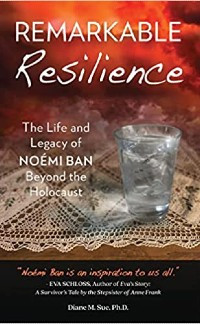 Remarkable Resilience: The Life and Legacy of Noemi Ban Beyond the Holocaust, by Diane M. Sue, Ph.D.
Remarkable Resilience: The Life and Legacy of Noemi Ban Beyond the Holocaust, by Diane M. Sue, Ph.D.
After enduring Nazi imprisonment and losing most of her family during the Holocaust, Noemi Ban was slowly recovering from her traumatic past – until the Hungarian Revolution of 1956. Terrified by a resurgence of Nazi sentiment, and the increased tyranny of the Soviet regime, Noemi summoned her courage and guided her husband and young sons through a successful escape into Austria. Welcomed into the United States as a refugee, Noemi navigated the complexities of life as an immigrant and returned to her teaching career, yet remained silent about her experiences as a Nazi prisoner. It wasn’t until her 70’s that she began sharing her experiences. She then dedicated the next three decades to telling others about the Holocaust. Remarkable Resilience Discussion Questions
Salvaged Pages, By Alexandra Zapruder
This stirring collection of diaries written by young people, aged twelve to twenty-two years, during the Holocaust has been fully revised and updated. Some of the writers were refugees, others were in hiding or passing as non-Jews, some were imprisoned in ghettos, and nearly all perished before liberation. Salvaged Pages Teacher Guide
Survival in Auschwitz, By Primo Levi
The true and harrowing account of Primo Levi’s experience at the German concentration camp of Auschwitz and his miraculous survival.
The Unwanted: America, Auschwitz and a Village Caught in Between, By Michael Dobbs
Drawing on previously unpublished letters, diaries, interviews, and visa records, Michael Dobbs provides an illuminating account of America's response to the refugee crisis of the 1930s and 1940s. He describes the deportation of German Jews to France in October 1940, along with their continuing quest for American visas. And he re-creates the heated debates among U.S. officials over whether or not to admit refugees amid growing concerns about "fifth columnists," at a time when the American public was deeply isolationist, xenophobic, and antisemitic.
